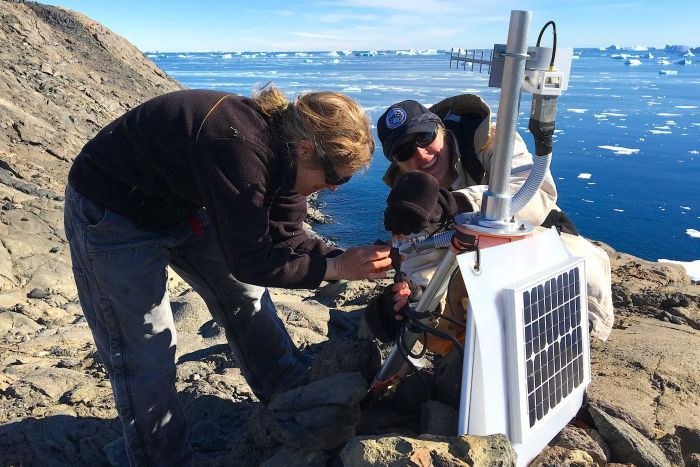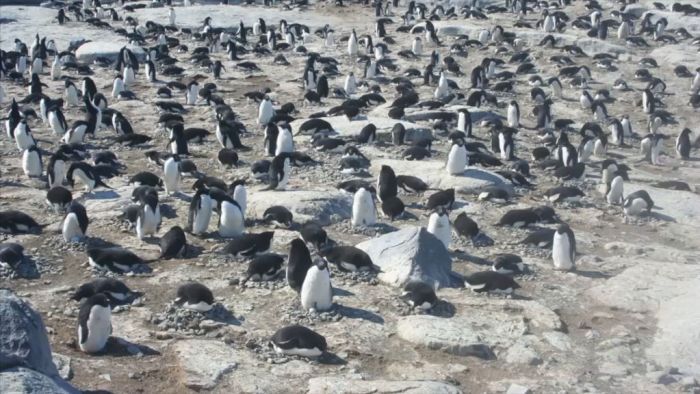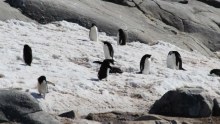New tracking technology gives Australian scientists unprecedented access to seabirds in Antarctica
Updated
Antarctica can be a harsh and inhospitable place to live and work, yet it is an environment scientists are determined to find out more about.
Climate change appears to be occurring on the icy continent before anywhere else.
The birds and animals there are considered to be early indicators of change.
New tracking technology is giving Australian scientists an unprecedented insight into the hidden world of seabirds, considered to be the sentinels of climate change in the Antarctic.
"It's quite magical really, this tiny tracker on the bird can go out and collect a whole heap of locational information for us and we can get it back without ever having to handle the bird," Dr Anna Lashko said.
Dr Lashko is working from Australia's Davis station over summer with PhD student Phoebe Lewis.
They have been attaching tiny trackers on Adelie penguins and flying seabirds such as Cape petrels.
Mini solar-powered tracking technology
The latest technology from Poland weighs between five and seven grams and is so small it can be attached to the feathers or legs of petrels.
One of the trackers is powered by a tiny solar panel.
"The solar panel charges the battery of the tracker so it can hold the locational data it's collecting, then when it returns within range of the base station that data gets transferred to the base station," Dr Lashko said.
The other is a miniature new light sensor powered by a tiny battery. It stores information about the bird's movements right through winter.
"It's really amazing. It's enabling us to get information from the birds that we just couldn't get before," Dr Lashko said.
Two hundred and fifty breeding pairs of Cape petrels are nesting on Bluff Island, a rocky outcrop in Prydz Bay surrounded by icebergs in summer and locked in by sea ice in winter.
In summer Dr Lashko and Mr Lewis travel by boat to the island — earlier in the season it was still possible to walk or drive out across sea ice.
The scientists have set up a remote data retrieving station on its peak.
It is a short climb up a rocky hill to the data point where Dr Lashko hooks up her laptop and uploads the information, collected from birds with trackers that are revisiting the island.
"When the birds with the trackers come back within about 500 metres of the base station, the data comes into the base station and that is what we are seeing," she said.
"For each individual bird that's returned we can see locational data and dive data, so the tracker knows when the bird gets wet and when it returns, it's really wonderful to see how many have returned."
 Photo:
Dr Anna Lashko and Phoebe Lewis on Bluff Island downloading data about Cape petrels. (ABC News: Mark Horstman)
Photo:
Dr Anna Lashko and Phoebe Lewis on Bluff Island downloading data about Cape petrels. (ABC News: Mark Horstman)
The smart technology is also able to switch the trackers off when the birds come into range of the island to save the battery.
Lead researcher Dr Louise Emmerson was in the Antarctic at Davis station in Spring last year. She is particularly excited about the developing technology of trackers.
"This new technology has really opened up our capacity to understand this, particularly for the flying seabirds which requires smaller and lighter devices, and we would prefer to minimise our handling of the birds," she said.
 Photo:
During winter the Adelie penguins travel up to 3,500 kilometres away from their colonies. (ABC News: Fiona Breen)
Photo:
During winter the Adelie penguins travel up to 3,500 kilometres away from their colonies. (ABC News: Fiona Breen)
Researchers have been tracking Adelie penguins for about 10 years — 26,000 breed on Gardner Island near Davis station.
Females take long trip after laying eggs to restore energy
The penguin trackers the researchers use are matchbox size and weigh about 45 grams.
They are attached to the bird's back but scientists need to retrieve those trackers every few weeks and recharge the batteries.
"One of the things we've learnt from the trackers is that the female Adelie penguins, once they've laid the eggs, go off on quite a long trip," Dr Lashko said.
"They can travel up to 450 kilometres away from the colony while they're replenishing the energy they spent laying those eggs.
"Then two or three weeks later, they come back to the colony and swap over with their male partner."
The trackers with longer lasting batteries have given the team some great insights into the lives of Adelie penguins over winter — satellite trackers have clocked them travelling great distances for food.
"During winter, the Adelie penguins travel up to 3,500 kilometres away from their colonies, staying mainly at the ice edge and going no further than about 60 degrees south," Dr Emmerson said.
Remote cameras developed by the Australian Antarctic Division are also giving scientists a unique insight into life.
Time lapse footage shows the colony growing and contracting over 12 months.
"The network of cameras has provided windows to the world of breeding birds and the fate of their chicks in remote areas around Antarctica and at times of the year when accessing those sites is nearly impossible," Dr Emmerson said.
Feeding game is a life and death battle
On our visit in February adult penguins were returning home to Gardner Island from much shorter trips, with food for their big fluffy brown chicks.
The chicks wait in so-called crèches with just a few adults looking after them.
When the parents return to the island and walk the "penguin highway" from the water to the crèche, there is pressure to cough up, literally, a mass of regurgitated krill and other fish bits as soon as possible.
What ensues is a hilarious game of chasings.
"You see the chicks chasing the parents looking for food, stumbling over the rocks and the parents running away," Ms Lewis said.
"I think it's a competition sometimes. They have siblings so whoever is fastest gets the most food, which is kind of hilarious to watch."
Ms Lewis, a biologist, loves to observe their feeding behaviours.
 Photo:
The survival of the chicks depends on how much food they get from their parents. (ABC News: Fiona Breen)
Photo:
The survival of the chicks depends on how much food they get from their parents. (ABC News: Fiona Breen)
"It's also maybe a little bit of training over rough ground, just running and falling and finding their feet," she said.
It might be comical to watch, but this feeding game is a life and death battle.
"There can be very high mortality of the chicks between the time that they hatch until the time that they fledge from the breeding sites," Dr Emmerson said.
Their survival depends on how much food they get from the parents.
Every year as the latest technology gets smaller and smaller its place in the Antarctic grows and grows, and scientists in this harsh and difficult environment are thrilled with the results.
"The new technology has revolutionised our capacity to reach into the harsh and inhospitable Antarctic environment to understand how the birds navigate their landscape and identify their critical foraging areas," Dr Emmerson said.
Topics: birds, animal-science, climate-change, antarctica
First posted










